The two-part workshop “LandPKS: A Tool for Producers” took place on July 23rd, 2021 in San Luis, Colorado, and on the surrounding lands. Organized by collaborating partners from Colorado Open Lands, USDA-ARS, NRCS, and Colorado State University, the purpose of the workshop was to introduce land managers in the San Luis valley to using LandPKS to access data and information to help support management decisions.
The first part took place under a tent in the courtyard of a community center in San Luis, and consisted of a conversation about land management challenges in the San Luis valley and an introduction to using LandPKS. Settled under the tent holding cups of coffee, we began with introductions and a casual conversation about priorities and challenges in the valley. When it came to land management challenges in the area, the answer was nearly unanimous: water. Many of the workshop participants had been struggling with drought since 2002. “Runoff is happening earlier and earlier each year. There’s too much water too early and not enough when we need it,” one participant, a rancher, said.
The local wildlife has changed its patterns due to lack of water, another participant added. He had observed a reduction of wildlife and beneficial insects. “Creeks are drying out and riparian areas are suffering,” he said. “There is also very little topsoil and soil organic matter here,” another participant chimed in. Lack of topsoil and soil organic matter can slow down the time it takes for water to infiltrate the soil, and the conversation shifted to manure and ways to make the most of the available water. We concluded the discussion in agreement about the importance of ditch maintenance.
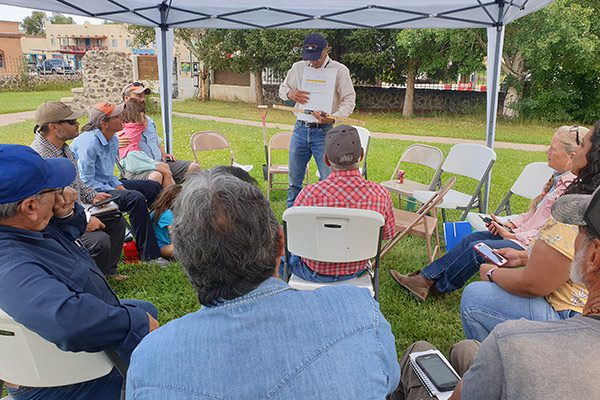
© LandPKS
“You don’t have to send your soil to a lab to learn what it is and observe if it’s getting better,” said Jeff Herrick, LandPKS Global Lead. He provided an overview of the varied possible uses of LandPKS: “It’s important to know about your soil for everything from septic design, to rangeland management, to finding good soils for adobe brick fabrication.” The San Luis valley has very diverse soils, which makes it all the more important for land managers there to know what soils they have on their land. This knowledge enables them to identify the most productive soils on their land so that, for example, increasingly limited irrigation resources can be allocated.
We walked through how to get set up on LandPKS and create a site. After a brief introduction to the LandPKS modules and functions, including the LandInfo, Vegetation, and Habitat modules, one participant, who was learning on another person’s device, said, “maybe I’ll finally get a smartphone now!”
Part two of the workshop was a field demonstration of how to use LandPKS to learn about the soil at a specific site, which took place on a local rancher’s land. Undeterred by the rain, we sampled soil from a two-foot hole which we had pre-dug with the landowner. Rolling the soil into balls and pressing it into ribbons, we observed the high clay content of the soil. In addition, we used LandPKS to access local ecological site information at that specific spot.
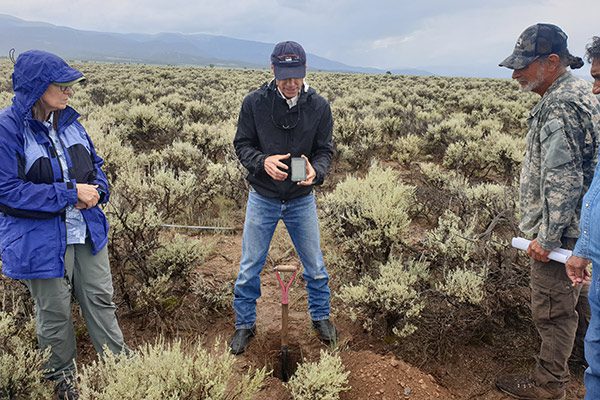
© LandPKS
During the closing reflections in the field, several participants said that what they had learned at the workshop was useful and expressed interest in a follow-up workshop later this year. Particular interest in the Vegetation and Habitat modules was expressed. When asked what the most important thing they had learned at the training was, one participant said that he learned how to use LandPKS to determine how to best use his land while also enhancing its ecology. Another participant said, simply, “That this tool exists!”
See details about upcoming in-person training events and webinars here.
The Habitat Module’s Features and Functions
The Habitat module can help determine if you are fostering the conditions required for key species on your land. Habitat information and data collected in the app can be used to develop goals, guide management actions, and develop monitoring plans.
This teaser video briefly introduces the Habitat Module and its main features and functions:
Learn about Wildlife Species and their Habitat Requirements
Habitat currently includes a selection of 22 plants, mammals, birds, reptiles, and insects that occur in North America, including monarch butterflies, pronghorn antelope, and ornate box turtles. As soon as a plot is created, the app will display a list of species that may occur at the location based on the known range of each species. Selecting a species displays the habitat requirements. After you have collected vegetation or soil data, the app will display your data in the same table, side-by-side with the species’ habitat requirements.
See the species factsheets for in-depth information about habitat characteristics. The factsheets are available in two places: in the app (including offline) and in the Knowledge Hub on LandPotential.org.
In this video, meet the two main instigators of the LandPKS Habitat Module, Terri Schulz and Tegan May, and learn about why they thought it was important that data about soil and land be tied to information about wildlife species:
Designed for a Wide Range of Users
The LandPKS Habitat Module is designed for a wide range of users, including:
- Ranchers
- Farmers
- Wildlife enthusiasts
- Homeowners
- Educators
- Open space and other land managers
And anyone else who is interested in conserving and managing for wildlife habitats on their land. Habitat can be used for both planning and educational purposes, on ranches and in schools, in suburban neighborhoods and on wildlife preserves.
Get Started Using Habitat!
This video quickly demonstrates how to use the LandPKS Habitat Module:
Learn more about the Habitat Module, and access species factsheets, in the Knowledge Hub. Download the LandPKS mobile app in the Apple App Store or the Google Play Store.
Many thanks to our partners in developing the Habitat Module:
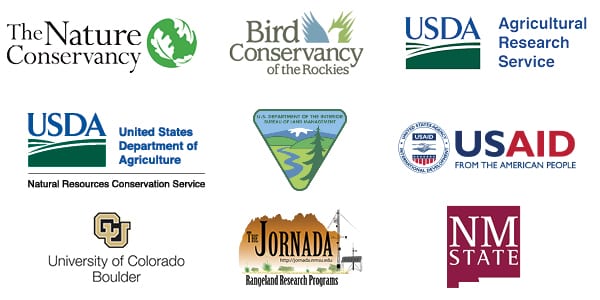
This work was funded by an NRCS Conservation Innovation Grant and matching private donations.
Part two in a series of blog posts that tells the story of how Eco-Cycle and LandPKS came to collaborate. It also tells a bigger story: one about synergies between organic waste management and soil health. If you haven’t yet, read part 1 first.
After over a decade of managing Gem o’ the Field, an organic farm just north of Boulder, Colorado, Dan Matsch found himself at a crossroads. He had just turned forty. Though Gem o’ the Field did brisk business at the Boulder County Farmers Market and was making a modest profit, Dan still didn’t have the funds to hire the full-time management staff he desperately needed. So, in 2001, Dan planted his final season of crops. That same year, he joined Eco-Cycle, where he already served on the volunteer board of directors, as an employee.
When Dan joined Eco-Cycle, the company was focused on one big question: how to build zero-waste communities. They steered their attention specifically towards organic waste. Comprising about 30% of the total waste stream, organic waste includes food scraps and garden trimmings, and, if uncontaminated by other waste such as plastic, is entirely compostable. The directors of Eco-Cycle wanted to look into the possibilities of composting on local organic farms. It was a research project, and they asked Dan to take it over.
After over a decade of working as an organic farmer and building his own compost, Dan seemed predestined for the job. However, he quickly unearthed an inconvenient fact: the State of Colorado does not allow for organic waste to be brought to farms for composting. The project was a dead end, its premise against state regulations. For a couple of years, Dan put composting on the back burner to work on another new Eco-Cycle initiative: the CHaRM.
Welcome to CHaRM
In the same year that Dan joined the staff, Eco-Cycle opened its Center for Hard to Recycle Materials, or CHaRM, and they asked Dan to manage it. The first facility of its kind in the United States, CHaRM began by recycling select electronics. Today, CHaRM recycles all types of electronics, as well as hard-to-recycle plastics, packing materials, appliances, mattresses, and more. Thinking back on the intensity of those first years at Eco-Cycle, Dan says, “the reality was, I hardly had any time to think about compost, because I was the only employee at CHaRM!”
Composting and recycling in Boulder, Colorado, in the early 2000s looked very different than it does today. The City of Boulder had no curbside program for organic waste collection, except for yard-waste, until 2006. In 2004, Eco-Cycle launched Colorado’s first commercial food waste collection program. Because of the special kind of truck required for residential hauling, Eco-Cycle stuck with the commercial side of things, picking up organic waste from restaurants and grocery stores and hauling the waste to A1 Organics in Golden, Colorado.
Also around this time, Dan and his colleague were shown a compost tea brewer at a trade show. They bought it on the spot, and Dan started brewing compost tea at CHaRM. “By then, a bunch of people were excited about recycling their organics, so we let people come to CHaRM with their kitchen scraps,” Dan explains. At CHaRM, this waste was vermicomposted to brew a “tea” of beneficial soil microbes and soil nutrients, which could then be poured into a watering can or an irrigation system and easily distributed across cropland. It wasn’t the massive on-farm composting program with curbside pickup that Dan had once dreamt of implementing, and didn’t have the benefit of adding organic matter to the soil, but it was a quick and easy way to start creating a compost product at CHaRM.
Back to the Farmers Market
If there was a single message that Eco-Cycle sought to convey in the early 2000s, it was that zero-waste and composting went hand-in-hand. In 2004, Eco-Cycle launched their first zero-waste event at Dan’s old stomping grounds, the Boulder County Farmers Market. It gave Dan a strange feeling to go back to the farmers market, which he had just left three years ago, to present them with the idea. However, his familiarity with the market was an advantage when it came to organizing the event. “I promised them we would take care of everything,” Dan recalls.
Zero-waste events were a brand-new concept, and Dan and Eco-Cycle needed to define the parameters. There would be no trash cans, only recycling and compost bins. Food vendors would be required to use compostable food packaging. A1 organics had agreed to receive the compost from these events. Sometimes, a few of Eco-Cycle’s dedicated volunteers would act as goalies for the bins, making sure that people put the right types of waste in each. However, Dan found that the most critical factor was signage design. It was crucial that the bins had clear, appealing signage so that people could comply with the disposal rules.
Dan and others Eco-Cycle thought that, as long as they were present at the farmers market, they might as well sell a product. As BCFM only allowed vendors to sell what they’d produced themselves, Eco-Cycle began selling their compost tea. But as a former BCFM vendor, Dan wanted to make sure that the product he was selling actually worked, so he began conducting compost tea trials at CHaRM and on his old farm.

Bottles of Eco-Cycle’s microbe brew tea in the fridge
Dan’s experiments were not particularly scientific, but they did seem to indicate some benefits of applying compost tea. “For example, I had this big, empty greenhouse at the farm. Every year we would have an outbreak of grasshoppers inside the greenhouse. I planted some trays of basil in the greenhouse, half with and the other half without tea. But I had completely forgotten about the grasshopper outbreak! I showed up one day and immediately knew: oh no, the grasshoppers had hatched. The control basil was shotgun-riddled with holes. On the test side that had been treated with compost tea, there were only a couple of holes.” Dan’s interpretation was that the tea’s microbes seemed to build healthier soil, which grew healthier plants.
It became Dan’s passion to demonstrate to people that it’s possible to create high-value products like compost tea out of food waste.
A transformative moment for Dan was hearing John Wick of the Marin Carbon Project speak at a conference in 2012. Wick’s message of hope for climate change mitigation through what he called “carbon farming” gave Dan “a new sense of purpose. When I heard him make this connection between compost and climate change, bells went off.” From then on, educating people about the connection between soil health and climate change became Dan’s mission, and Eco-Cycle and CHaRM would provide him with the scaffolding for outreach and collaboration that would enable the next decade of his career.
This post is part one of a three-part series about the story of LandPKS’s partnership with Eco-Cycle. The series also tells a bigger story: one about synergies between organic waste management and soil health.
Like soil, life has layers. We go through phases and, more often than not, certain themes recur. Some collaborations only happen on the surface; others take root much deeper, connecting multiple layers of experience. This series of blog posts tell the story of how Eco-Cycle and LandPKS came to collaborate. It also tells a bigger story: one about synergies between organic farming, organic waste management and composting, and the health of soil. This first blog post tells the story of Dan Matsch, Manager at Eco-Cycle, and how he came to understand the fundamental connection between our two organizations.
“The farm was like Disneyland for me.”
Every summer when Dan Matsch was a little kid, his family would drive from Colorado to Iowa, where his uncles owned a farm. Dan loved it there: the animals, the tractors and equipment, and being outside. “The farm was like Disneyland for me,” he says. However, growing up just east of the Rocky Mountains near Denver, where summers are short and the climate is dry, farming didn’t have much appeal, and Dan wouldn’t be reintroduced to farming until he was in his twenties.
For college, Dan studied architecture at the University of Michigan, but his real education began after graduation. He stayed in Ann Arbor and rented a room in a house that was owned by one of the founders of Recycle Ann Arbor, a non-profit waste management agency. Through his housemate connections, Dan started working at Recycle Ann Arbor too, which began his career in the recycling business. Yet, an even more formative experience he had while living in that house was farming in the backyard.
“I was recycling for a job and gardening for fun.”
Reflecting on his first summer in that house, Dan says that the backyard “seemed completely wild to me. It was a jumble of trees and shrubs. I had no idea what was going on back there.” However, soon his housemates started bringing fresh fruit and vegetables in from the yard — “incredible stuff,” he remembers. “I can remember the first time my housemate came into the house and handed me a peach. I didn’t even know there was a peach tree out there. It tasted outrageous.”
In addition to the taste of the food, Dan loved the idea of providing for himself. There was an appeal to self-sufficiency, of growing something from start to finish. He sums up that period in his life this way: “I was recycling for a job and gardening for fun.”
A few years later, Dan enrolled in a program for agroecology at the University of California Santa Cruz. The program is built around a working farm, which the small cohort of under 30 students is responsible for keeping afloat. Looking back on the experience, Dan says, “It was fabulous. Immersive. You live there, you work there, you’re all in. I can’t imagine better preparation for farming on your own.”
Dan met his wife, Carol Conigliaro, in the program, and they planned to remain in California to farm after graduation. However, the plan changed when his sister married and Dan came back to Colorado for the wedding. His parents had purchased a new property in Boulder County. While visiting, he saw some organic farming going on in the neighborhood and thought to himself, “Good enough!” He told Carol that he thought it could work, and she was open to the idea. In 1989, they moved to Colorado to start a new farm on the family land.
Gem o’ the Field
“You couldn’t start more from scratch than we did, beginning with the soil, or lack thereof. It was very sandy and thin,” Dan says. Though he had ordered some lab tests of soil samples and talked to the neighbors about their land, it wasn’t adequate to really understand the variety of soil conditions on their farm, which they named Gem o’ the Field. Located on the Left Hand Creek floodplain, the land had been scoured by fast-moving water, which left rocks and rubble behind. As Dan dryly puts it, “it’s not exactly the Nile floodplain.”
In addition to the difficult soil, Dan recalls that there was no infrastructure to speak of: no irrigation system, no power, and no equipment. In spite of the significant challenges at the beginning, they made it work. With some help from his dad, Dan bought an old tractor. Dan learned how to weld, and they built a greenhouse for starting transplants.
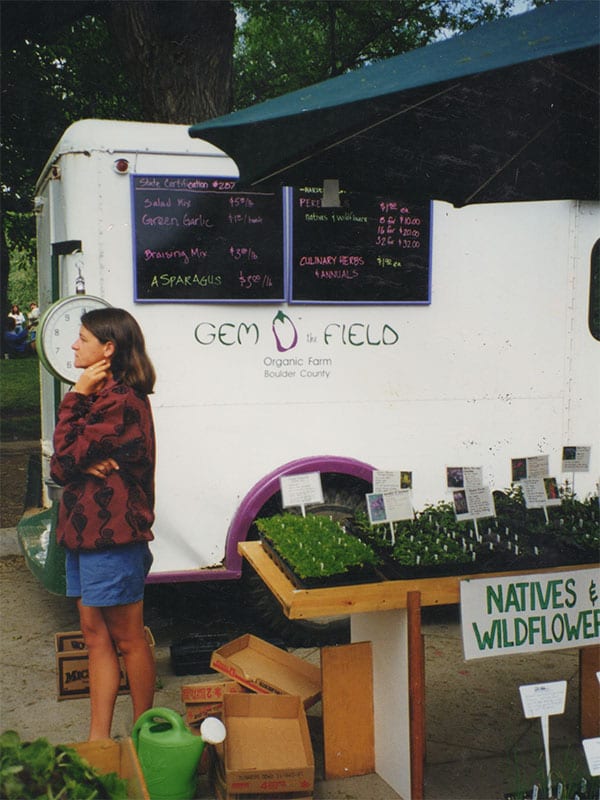
Carol Conigliaro at the Boulder County Farmers’ Market stand with the milk truck, circa early 1990’s. They sold native and wildflower starts in the spring for early income. © Dan Matsch
Because the farm was at the base of the foothills, Dan and Carol could grow cool-season crops through the summer. The Boulder County Farmers’ Market was a good way to ease into the market, and theirs became the go-to stand for mixed greens. They bought an old milk truck to keep their produce fresh at the market, which gave them an extra competitive edge. After a couple of years, the farm was working, and Dan and Carol were making a modest income.
When it came to planning, however, Dan and Carol had different aspirations. While Dan was focused on improving infrastructure and expanding the farm, Carol wanted to pursue other activities in the off-season. Eventually Carol went back to school and got a degree in Chinese medicine and Dan continued to run the farm without her. “But you know, it eventually caught up with me,” he says.
“I had employees, and this new burden of accounting and payroll. I wasn’t realistic about the time that took. I would do it in evenings and in my spare time, but it became all-consuming. For at least nine to ten months of the year, I was on seven days a week, slowly burning myself out. I loved it, but I had to face the fact that my body was kind of breaking down.”
The Flood
When Dan turned 40, he reevaluated. The farm was on marginal land and there was no clear possibility of expanding into better ground. He thought that, if he wanted to keep farming, he would have to start over somewhere else. “I didn’t feel like I was up for that,” he says. Dan stopped farming in 2001 and returned to his first line of work—the recycling business. He’s been working at Eco-Cycle ever since.
In 2013, a big flood swept across the Left Hand Creek floodplain. They had 18 inches of rain over the course of three days in September, usually one of the driest months. The flood washed away ten acres of topsoil. Dan says he will never forget walking through the property after the water subsided. He saw his soil profile for the first time in the eight-foot-deep arroyos: “The topsoil was sandy, but ok. Below it was two feet of rubble, then another six inches of topsoil, then another two feet of rubble, then another six inches of topsoil. That completely changed my perspective on the land, and I understood why I was having so much trouble.” Over three days, a flood revealed why ten years of farming had been so challenging.
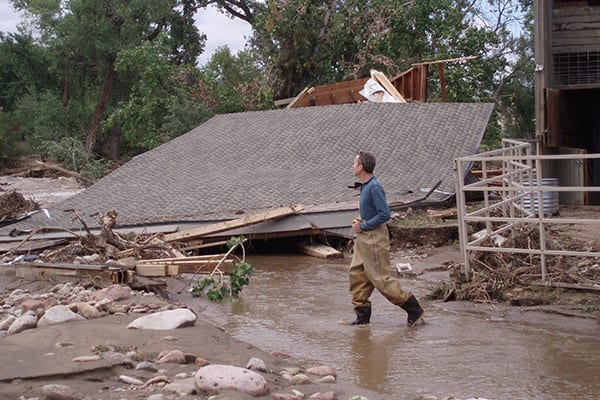
Dan surveying damaged barns from September 2013 flood, © Dan Matsch
“If I had had LandPKS at that time, I really doubt that I would have farmed there.”
LandPKS could have helped them in several ways, Dan explains. First of all, LandPKS could have helped them track management decisions and better understand what methods worked. Just trying to keep the soil moist required constant work, and Dan estimates that he spent a quarter of his time moving irrigation pipe. Though they paid a lot of attention to their soil, they didn’t have good tools for measuring it or for documenting their soil management decisions. Dan says that the LandPKS LandManagement module could have helped him keep better records and see some patterns that eluded him as a farmer.
The LandInfo module also could have been of use. “LandPKS offers immediate feedback, which would have been helpful to get a better sense of the whole property. The irony of it was, we were using the wrong part of our land,” Dan tells me. “Left Hand Creek bisected our property: the floodplain is on one side, and that’s where all of the development was. Across the creek, it’s a completely different ecosystem.”

Carol irrigating the “big” field, © Dan Matsch
There were a number of challenges associated with expanding across the creek, including the necessity of hiring more employees, and it took seven years before Dan was ready to do it. When he eventually did expand the farm to the other side of the property, he discovered the soil was a Valmont, much better soil for agriculture. “If we had had LandPKS, we would have learned exactly what that soil across the creek was from the start, and that could have completely changed what happened.”
For Dan, farming in Boulder County was bittersweet. “We had a good 13-year run. Our stuff was good. We poured our heart and soul into it and it showed. We had a really good reputation at the farmer’s market. I had a lot of pride in what we were able to accomplish under pretty tough conditions, but I wouldn’t do it again, and if I had had LandPKS at that time, I really doubt that I would have farmed there.”
Back to Recycling
Over the years, Dan and Carol learned a lot about soil. Since their sandy soil required a lot of added organic matter, Dan began making his own compost out of manure from a nearby goat dairy. Eco-Cycle, one of the oldest and largest non-profit recyclers in the United States, approached Dan when he stopped farming. They needed someone with composting expertise who could take on the challenges of organic waste management. The initial idea was to transport organic waste to local farms, where the composting would then happen on site. Did that work, I asked Dan? “No. But there are other possibilities, and I’ve spent the last 19 years trying to figure that out.”
Continue reading part 2 in this series.
Like many of us around the world impacted by COVID-19, the LandPKS team is adapting to our new circumstances of working and learning from home. In an effort to make a small contribution to assist those looking for at-home resources for the whole family, LandPKS is starting a video series for learners of all ages. In the video series, you can discover how to use LandPKS to better understand the land around where you live, keep records, and monitor changes in soil health and vegetation.
We hope these videos can help support distance learning for students of all ages, families, and teachers during this time. The video series will encourage exploration and hands-on learning with the LandPKS mobile app. Just like the LandPKS app, the videos are designed to be used anywhere in the world.
The first video in the series explains why soils are important and how to use LandPKS to identify your soil texture. The video also demonstrates how to find out what types of soil are near your location or a location anywhere in the world. You can watch the video on the LandPKS YouTube Channel.
Stay tuned for more videos!
